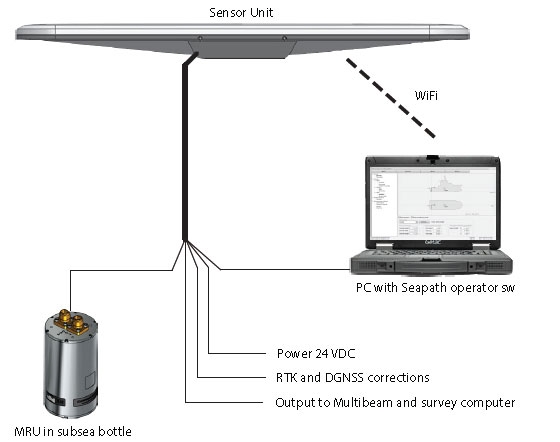A compact and robust integrated INS/GNSS system, Seapath 130 is developed specifically for hydrographic surveying where high precision heading, position, roll, pitch, heave and timing are critical measurements. The product combines state-of-the-art dual frequency GNSS receivers, inertial technology and processing algorithms in a compact and portable package. Designed for easy transport and quick integration on board, the portability offered by the Seapath 130 series makes it the ideal companion for the brand-new KONGSBERG EM 2040P multibeam system. Seapath 130 is also optimised to work with other KONGSBERG developed hydroacoustic systems including the M3 Sonar and Geoswath Plus shallow water multibeam, in addition to EM and EA echo sounder models and configurations.
KONGSBERG offers three Seapath 130 variants, ensuring suitability for a wide range of survey applications. The Seapath 134 with MRU H provides 0.03° roll and pitch accuracy and is ideal for shallow water surveys. The Seapath 135 with MRU 5 delivers up to 0.02° roll and pitch accuracy making it an optimal solution for surveys in deep water. The Seapath 136 with MRU 5+ MK II provides up to 0.008° roll and pitch accuracy, so can be used for surveys with high angular coverage in deep water.

The main component of Seapath 130 is the Sensor Unit with integrated GNSS antennas and receivers. The Sensor Unit mounts on top of the vessel mast or a pole. On top of the transducer, the inertial sensor (MRU H, 5 or 5+) is mounted in a lightweight subsea housing, while the Seapath operator software is installed on a connected PC for configuration and monitoring. All components are connected through a spider cable with MRU connection, three configurable output serial lines, DGNSS correction input, 1PPS output, network communication and power. Seapath 130 products have three configurable RS-232/422 serial lines and Ethernet for output of motion data and NMEA messages to the multibeam and survey computer. Input of DGNSS corrections of various quality and sources are on a configurable RS-232/422 serial line or Ethernet.
The Seapath 130 use advanced Seapath navigation algorithms integrated with RTK GNSS data and inertial sensor data from the MRU (Motion Reference Unit). This gives Seapath 130 unique advantages compared to stand alone RTK GNSS products. Seapath’s accurate roll, pitch and heading measurements allow the RTK antenna position to be referenced to any point on the vessel where accurate position and velocity are required. There is no accuracy degradation in roll, pitch and heave measurements during turns. All data from Seapath has the same time stamp and the output is in real-time, while subdecimetre position accuracy can be achieved by downloading satellite orbit and clock data from the Internet and through post processing of satellite and IMU (inertial Measurement Unit) data.
